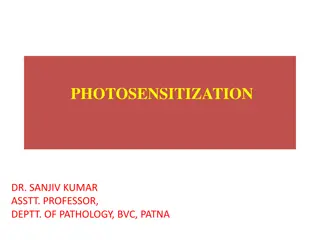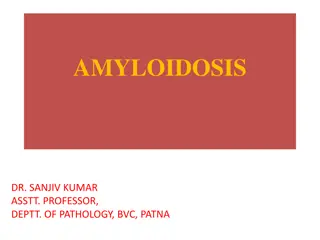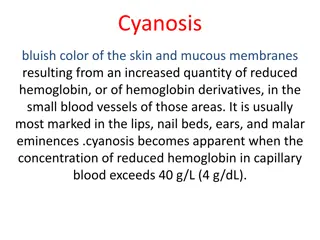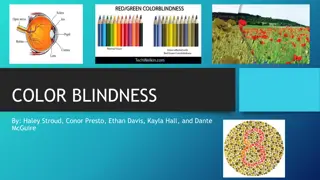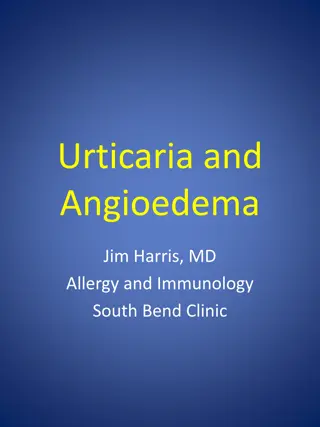Understanding Urticaria: Causes, Types, and Management
Vascular reactions of the skin like hives and nettle rash can lead to urticaria, characterized by wheals, itching, and stinging sensations. Chronic and acute urticaria have distinct classifications and triggers, including drugs, food, infections, emotional stress, and physical factors like cold and heat. Recognizing the various etiological factors and triggers of urticaria is crucial for effective management and treatment.
Download Presentation

Please find below an Image/Link to download the presentation.
The content on the website is provided AS IS for your information and personal use only. It may not be sold, licensed, or shared on other websites without obtaining consent from the author. Download presentation by click this link. If you encounter any issues during the download, it is possible that the publisher has removed the file from their server.
E N D
Presentation Transcript
vascular reaction of the skin appearance of wheals urticaria severe itching, stinging, or pricking sensations Do not last longer than 24 hrs
Urticaria that persists for more than 6 weeks is classified as chronic Urticaria that persists for less than 6 weeks is classified as acute
Etiologic factors Drugs Penicillin and related antibiotics The incidence of aspirin-induced urticaria has fallen Aspirin-sensitive persons tend to have cross- sensitivity with tartrazine, the yellow azo- benzone dye. These are common food additives and preservatives. Aspirin exacerbates chronic urticaria in at least 30% of patients unknown.
FOOD frequent in acute urticaria, less in chronic urticaria. chocolate, shellfish, nuts, peanuts, tomatoes, strawberries, melons, cheese, garlic, onions, eggs, milk,and spices. Food allergens that may cross-react with latex include chestnuts, bananas, avocado, and kiwi. FOOD ADDITIVES Fewer than 10% of cases of chronic urticaria. Natural food additives :yeasts, salicylates, citric acid, egg, and fish albumin. Synthetic additives include azo dyes, benzoic acid derivatives, sulfite, and penicillin.
INFECTIONS Acute urticaria may be associated with upper respiratory infections, localized infection in the tonsils, a tooth, the sinuses, gallbladder, prostate, bladder, or kidney. treatment with antibiotics for Helicobacter Chronic viral infections, such as hepatitis B and C. Helminths may cause urticaria EMOTIONAL STRESS NEOPLASMS : carcinomas and Hodgkin disease. INHALANTS : Grass pollens, house dust mites, feathers, formaldehyde, cottonseed, animal dander, cosmetics, aerosols, and molds
Physical urticarias Cold urticaria : on the face when cycling . Solar urticaria : within minutes of sun exposure. Heat urticaria :contact with hot objects+solutions. Cholinergic urticaria : Anxiety, heat, sexual excitement or strenuous exercise. The vessels over-react to acetylcholine sympathetic nerves in the skin. Aquagenic urticaria : precipitated by contact with water, irrespective of its temperature. liberated from
Dermographism This common physical urticaria,the mast cells releasing extrahistamine after rubbing scratching. linear wheals are therefore exaggerated triple response of Lewis. is the type most of skin or The an They can be reproduced by rubbing the skin of the back lightly at different pressures, or by scratching the back with a fingernail or blunt object.
Delayed pressure urticaria Sustained pressure causes oedema of the underlying skin and subcutaneous tissue 3 6 h later. The swelling may last up to 48 h and kinins or prostaglandins, rather than histamine, probably mediate it.
Hypersensitivity urticaria IgE-mediated (type I) allergic reaction. Allergens may be encountered in 10 different ways :
Autoimmune urticaria Some patients with chronic urticaria have an autoimmune disease with IgG antibodies to IgE or to FcIgE receptors on mast cells. Here the autoantibody acts as antigen to trigger mast cell degranulation.
Contact urticaria IgE mediated or pharmacological effect. The allergen is delivered to the mast cell from the skin surface rather than from the blood. Wheals occur most often around the mouth. Foods and food additives are the most common culprits drugs, animal saliva, insect repellents and plants. Recently, latex allergy has become a significant public health concern.
Pharmacological urticaria This occurs when drugs cause mast cells to release histamine in a non-allergic manner aspirin non-steroidal anti-inflammatory drugs angiotensin-converting enzyme inhibitors morphine
Presentation sudden appearance of pink itchy wheals anywhere on the skin surface. Each lasts for less than a day Lesions may take up an annular shape. Angioedema is a variant of urticaria that primarily affects the subcutaneous tissues, so that the swelling is less demarcated and less red than an urticarial wheal. Angioedema at junctions between skin and mucous membranes( peri-orbital, peri-oral and genital ).
The course depends on its cause. If the urticaria is allergic, it will continue until the allergen is removed, tolerated or metabolized. Urticaria may recur if the allergen is met again. Only half of patients with chronic urticaria and angioedema will be clear 5 years later. Those with urticarial lesions alone do better, half being clear after 6 months.
Differential diagnosis Insect bites or stings and infestations Erythema multiforme urticaria. urticarial vasculitis: individual lesions last for longer than 24 h, blanch incompletely,leave bruising. Some bullous diseases ( dermatitis herpetiformis, bullous pemphigoid and pemphigoid gestationis) begin as urticarial papules or plaques, but later bullae make the diagnosis obvious. On the face,erysipelas can be distinguished from angioedema by its sharp margin, redder colour and accompanying pyrexia. can mimic an annular
Investigations more is learned from the history than laboratory. A review of systems. Careful attention should be paid to drugs investigations can be confined to a complete blood count and erythrocyte sedimentation rate (ESR). An eosinophilia should lead to the exclusion of bullous and parasitic disease raised ESR might suggest urticarial vasculitis or a systemic cause. Prick tests are unhelpful.
Treatment The ideal is to find a cause and then to eliminate it. antihistamines are the mainstays of symptomatic treatment. Cetirizine 10 mg/day and loratadine 10 mg/day shorter acting antihistamines( hydroxyzine 10 25 mg). H2-blocking antihistamines (cimetidine) Chlorphenamine or diphenhydramine are used during pregnancy Sympathomimetic agents can help urticaria, adrenaline A tapering course of systemic corticosteroids Low doses of ciclosporine






